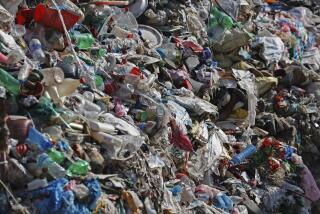Nepal Bans Glass Bottles Around Mt. Everest
- Share via
KATMANDU, Nepal — From a distance, Mt. Everest looks pristine, rising out of the Himalayas like a monument to nature’s power. It’s only up close that the evidence of man’s neglect can be seen.
The worst of the litter strewn on Everest’s slopes is the glass bottles, so heavy and unwieldy that no incentive could persuade trekkers to carry them back down rather than discard them at campsites. Shards of glass threaten the feet of village children as well as adventurers.
So last August, the Nepalese government banned the sale in the Everest region of beer and soft drinks in glass containers. A few months into the ban, officials say the idea is working.
Even at weekend markets on Saturdays, when beer sales used to number in the hundreds of bottles, not a single bottle can be found, said Umesh Singh, a Ministry of Tourism official who recently returned to Katmandu from the region.
“Local villagers now understand why we did it and appreciate our efforts to keep the Everest region free from pollution and garbage,” said Singh, whose ministry monitors and regulates all mountaineering in Nepal.
Some locals even want the government to increase the size of the bottle-free zone.
When the government introduced the ban, it worried that hotel and restaurant owners along the trek route might oppose the action for fear it would be an inconvenience. But those who depend on tourism for their livelihood generally agree that cleaning up is a good idea.
“Foreign trekkers have always complained about beer bottles that are scattered all over the area. The ban should take care of that problem,” said Dawa Tshering, who runs a small restaurant in Thyangboche, a two-day walk from Jorsalle, the entry point to the Everest conservation area
Tshering added that since the ban has decreased the amount of beer available, more home breweries are making a traditional drink called chayang, sipped warm from a wooden mug through a bamboo straw. Chayang had been losing ground to beer.
The ban has meant other immediate benefits for locals. Beer packaged in aluminum cans earns a bigger profit because it is cheaper to transport than glass bottles. In addition, recyclers arrive at merchants’ doorsteps to buy crushed empty cans for the equivalent of 27 cents a pound.
Recyclers don’t want to deal with the heavy glass bottles that held beer and other beverages brought in on the backs of yaks and porters from Jiri. The 4 cents offered by recyclers for a bottle doesn’t even cover a fraction of the cost of hauling the empties back to the nearest airport.
An estimated 100,000 glass bottles wait in small stacks around the Lukla and Syanboche airports, and twice that many are scattered around villages on the route to Everest. The cost to fly out the bottles at just the two airports would be at least $44,000.
Of course, there are still litter problems--discarded plastic bottles. For now, the government isn’t banning plastic containers because they’re the only way tourists can carry drinking water. But trekkers are being encouraged to take along water-purifying tablets and use the same bottle for an entire trip.
The average 30,000 visitors to the Everest area each year leave behind about 200,000 beer and other beverage bottles. The visitors either fly from Katmandu to Lukla airport, in the Everest region, and walk five days to the base camp, or drive to Jiri, the last point for vehicles, and walk 75 miles to the base camp.
Since August, guards at a checkpoint in Jorsalle, an entry site into the Everest Conservation Area, have been going through cargo and allowing only drinks packaged in plastic and aluminum to pass. The ban is monitored by the Everest Pollution Control Committee, an agency financed by the Nepalese government and the World Wildlife Fund.
The ban has worked so well that locals want the exclusion zone extended all the way to Lukla, a day’s walk from Jorsalle, and even to the airport in Katmandu.
The enthusiasm of residents of the Everest region and government officials in the capital is shared by environmentalists.
“The ban was a good move on the part of the government,” said P. T. Sherpa of KEEPS-Nepal.
Sherpa, whose nonprofit organization educates trekkers about local culture and environmental awareness, said the glass ban should be extended to other areas.
Mathew Dean, a hotel manager from Sydney, Australia, who recently completed a three-week trek to Everest base camp, was enthusiastic about the ban.
“I did not see any beer bottles inside the conservation area . . . only old bottles stacked on the walls of lodges and hotels,” he said.
More to Read
Sign up for The Wild
We’ll help you find the best places to hike, bike and run, as well as the perfect silent spots for meditation and yoga.
You may occasionally receive promotional content from the Los Angeles Times.






